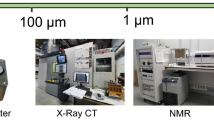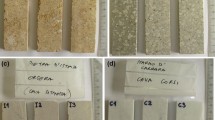Abstract
Over extended periods, long-lived radionuclides (RN) or activation products within geologic disposal sites may be released from the fuel and migrate to the geo/biosphere. In the bedrock, contaminants will be transported along fractures by advection and retarded by sorption on mineral surfaces and by molecular diffusion into stagnant pore water in the matrix along a connected system of pores and micro-fissures.
The objective of this paper was to determine the connective porosity and mineral-specific porosities for three granite samples by 14C methylmethacrylate (14C-PMMA) autoradiography. Scanning electron microscopy and energy-dispersive X-ray analyses (FESEM/EDAX) were performed in order to study the pore apertures of porous regions in greater detail and to identify the corresponding minerals. Finally, the porosity results were used to evaluate the diffusion coefficients of RNs from previous experiments which determined apparent diffusion coefficients for the main minerals in three granite samples by the Rutherford Backscattering technique.
The total porosity of the Grimsel granite (0.75%) was significantly higher than the porosities of the El Berrocal and Los Ratones granites (0.3%). The porosities of the Grimsel granite feldspars were two to three times higher than the porosities of the El Berrocal and Los Ratones granites’ feldspars. However, there was no significant difference between the porosities of the dark minerals. A clear difference was found between the various quartz grains. Quartz crystals were nonporous in the El Berrocal and Los Ratones granites when measured by the PMMA method, but the quartz crystals in the Grimsel granite showed 0.5% intra granular porosity. The apparent diffusion coefficients calculated for uranium diffusion within Grimsel granite on different minerals were very similar (210-13 ± 0.5 m2/s), but differences within both Spanish granites were found from one mineral to another (9 ± 110-14 m2/s in feldspars and 4.5 ± 0.510-14 m2/s in quartz) - always presenting lower diffusion values than in the Grimsel granite.
Similar content being viewed by others
References
K. H. Hellmuth, M. Siitari-Kauppi, and A. Lindberg, Journal of Contaminant Hydrology 13, 403 (1993).
K. H. Hellmuth, S. Lukkarinen, and M. Siitari-Kauppi, Isotopenpraxis Environmental Health Studies 30, 47 (1994).
U. Alonso, T. Missana, A. Patelli, J. Ravagnan, and V. Rigato, Nuclear Instruments and Methods in Physics Research B 207, 195 (2003).
U. Alonso, T. Missana, A. Patelli, V. Rigato, and P. Rivas, Journal of Contaminant Hydrology 61, 95 (2003).
P. Bossart, and M. Mazurek, Structural Geology and Water-flow paths in the migration-shear-zone Nagra Technical Report NTB 91–12, (1991).
N. Fernandez-Merayo, M. Siitari-Kauppi, M. Montoto, K-H. Hellmuth, Radiochimica Acta 74, 211 (1996).
Author information
Authors and Affiliations
Rights and permissions
About this article
Cite this article
Leskinen, A., Penttinen, L., Siitari-Kauppi, M. et al. Determination of Granites’ Mineral Specific Porosities by PMMA Method and FESEM/EDAX. MRS Online Proceedings Library 985, 1120 (2006). https://doi.org/10.1557/PROC-985-0985-NN11-20
Received:
Accepted:
Published:
DOI: https://doi.org/10.1557/PROC-985-0985-NN11-20




